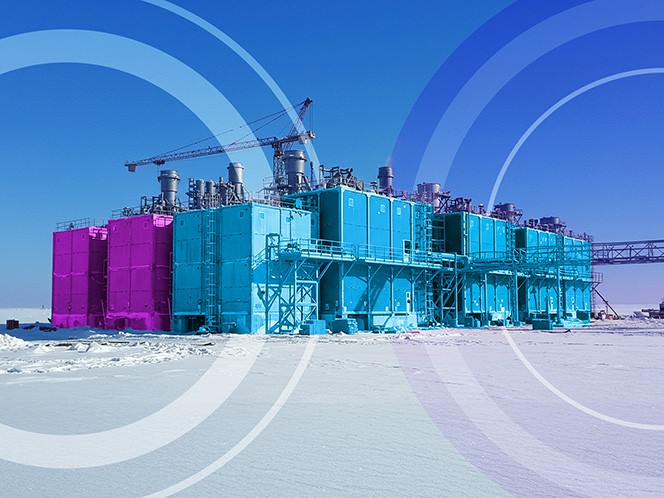Modular construction: a storied alternative for EPC firms
Posted: June 02, 2025

When Technip Energies set about building the Yamal LNG plant in Russia, they faced some major obstacles. Yamal is located on a remote Arctic peninsula. The region is icebound for nine months of each year, experiences polar night from November to February, and has an annual average temperature in the negative double digits of degrees Celsius.
How do you build a plant there, securely and efficiently? Technip and its partners adopted a modularization approach. Fabrication yards in Asia constructed 142 modules and 365 pre-assembled pipe racks, which were then shipped in for assembly. Now it is up and running as the world’s northernmost LNG facility.
The approach Technip adopted—modular construction, also referred to as prefabrication—is one with a long heritage. It is also one currently returning to the spotlight. For Engineering, Procurement, and Construction (EPC) firms, modularization offers some potentially powerful advantages—but also a specific set of challenges.
Our Industrial Life
Get your bi-weekly newsletter sharing fresh perspectives on complicated issues, new technology, and open questions shaping our industrial world.
Modular’s past and present promise
In our last piece on the topic, we delved into the surprisingly deep and diverse history of modular construction, an approach that has flourished in certain contexts going back centuries—even as far back as Ancient Rome, whose soldiers traveled with prefabricated wooden forts that they could quickly assemble and then defend on new territories.
Today, modularization appears to be on the comeback. Recent breakthroughs in 3D printing, BIM, automation, and delivery logistics optimization—coupled with the ongoing difficulties of making construction sites greener and leaner—have been tilting incentives increasingly towards the offsite production of standardized components in a controlled factory setting.
Modular structures are, in principle, quicker and cheaper to build. Factory construction also offers advantages in terms of on-site worker safety. Another driver is sustainability: modularization may have the potential to dramatically reduce waste, minimize water usage, and lower energy consumption and greenhouse gas emissions while making it easier to reuse materials from or entire segments of the completed building afterward.
Industrial manufacturing techniques have advanced while demand for rapid, cost-effective construction across diverse locations has grown—a trend likely to accelerate due to supply chain uncertainty and reshoring initiatives. Modularization therefore seems like a natural fit for EPCs that sometimes have to operate in remote and challenging environments.
The challenges and opportunities of modularization for EPCs
For EPCs, modular construction offers a specific set of additional advantages. EPCs can increase efficiency by moving construction away from sites that are hard to access, are prone to weather delays, offer insufficient space, or pose security concerns. Modularization is also more appealing for firms operating in places that lack a cost-effective and skilled local workforce. It may also help reduce project timelines through the efficient coordination of on-site and off-site phases.
According to Technip, buildings, process units, pipe racks, skids, and utilities can all be efficiently modularized—although reaping the full benefits requires early holistic project planning. Another potential advantage lies in the impact on local communities, with modularization decreasing a project’s dependence on local resources and impact on local infrastructure while reducing the need for temporary construction and storage areas on-site.
Yet the modular approach also has its drawbacks. Where logistics are easy and onsite work unproblematic, a stick-build approach is often more efficient. Project management, coordination obligations, and integration with existing structures may all prove challenging when modularization is involved; sourcing modules internationally can also increase exposure to global supply chain risk. Furthermore, EPCs might ask themselves if and how a certain facility does standardize—projects with highly specialized requirements resist the modular approach.
Some major players, therefore, have created tools to help them adjudicate the use of modularization on a case-by-case basis. Such tools consider factors like logistics, labor requirements, site specifications, and required modules to identify the optimal degree of modularization. George Saad, Vice President of Operations for Petrofac, said in 2021 that his firm had developed a decision matrix for whether a project should be stick-built or modularized. “We weigh up things like the contractual obligations, the timescales, the location of the site, the number of personnel able to work onsite, the availability of skilled labour locally, the logistics of bringing over-sized items onsite, and so on,” he explained. “And we come to the most logical decision.”
Offshore modular construction is taking off
Today, the most prominent adoption of modularization among EPCs seems to be concentrated in remote mining facilities and offshore oil and gas platforms—locations where on-site building poses obvious challenges. In addition to its Yamal plant, Technip has used modular construction for a floating natural gas unit off Mozambique and to build processing units on artificial islands under high heat conditions in the Arabian Gulf.
Petrofac, meanwhile, used modular construction to upgrade the Sriracha Refinery in Thailand, a site with no spare space and a client-imposed cap on on-site personnel. Saipem has used modularization for refinery projects in Canada and Suriname as well as the Escravos Gas to Liquid processing project in Nigeria, where a shortage of space and skilled labor onsite led them to ship in modules amounting to roughly 50% of the plant’s weight for local assembly.
In the nuclear industry, meanwhile, momentum has grown around the potential of Small Modular Reactors (SMRs). With a comparatively smaller footprint and simpler designs, these SMRs can be installed in a wider array of locations; they are better suited to modular construction than larger (typically custom-built) reactors, so many components can be prefabricated off-site and then transported in for assembly. SMR advocates point to advantages in cost and construction time as well as safety benefits once operational. As of February 2024, around 95 SMRs were being designed or constructed around the world; currently, Russia and China each already have one in operation.
The full potential for modular construction is yet to be realized. Still, Rome was not built—or even just assembled—in a day.